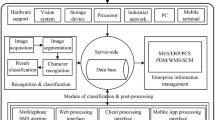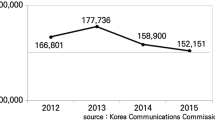Abstract
The automatic identification system of financial bills needs to have high recognition rate, high anti-interference and real-time to ensure its recognition effect. Based on the image recognition theory, this study uses the differential projection method to define the boundary of the bill. The horizontal projection gradation of the boundary area of the bill character line is significantly reduced from large to small, and the horizontal difference projection of the grayscale image can be performed to locate the boundary of the bill image. The word height of bills studied in this paper is constant, the character line spacing is equal, and the horizontal differential projection is used to realize row positioning. The main process of the system is to first select the check image, and then the software part realizes the process of image analysis, preprocessing, character segmentation, feature extraction, character recognition, etc. Finally, the recognized amount is output to the interface. It is proved by experiments that the recognition rate of this algorithm is high, which can provide theoretical reference for subsequent related research.









Similar content being viewed by others
References
Ma X, Yang R, Zou D et al (2020) Measuring extreme risk of sustainable financial system using GJR-GARCH model trading data-based. Int J Inf Manag 50:526–537
Zhang XY, Bengio Y, Liu CL (2017) Online and offline handwritten Chinese character recognition: a comprehensive study and new benchmark. Pattern Recognit 61(Complete):348–360
Zhong Z, Jin L, Xie Z (2015) High performance offline handwritten Chinese character recognition using Googlenet and directional feature maps. In: 2015 13th International conference on document analysis and recognition (ICDAR). IEEE, pp 846–850
Chatterji BN (1986) Feature extraction methods for character recognition. IETE Tech Rev 3(1):9–22
Pengchao LI, Liangrui P, Juan W (2016) Rejecting character recognition errors using CNN based confidence estimation. Chin J Electron 25(3):520–526
Liu W, Chen C, Wong KYK (2018) Char-net: a character-aware neural network for distorted scene text recognition. In: Thirty-second AAAI conference on artificial intelligence
Sarkhel R, Das N, Saha AK et al (2016) A multi-objective approach towards cost effective isolated handwritten Bangla character and digit recognition. Pattern Recogn 58:172–189
He M, Zhang S, Mao H et al (2015) Recognition confidence analysis of handwritten Chinese character with CNN. In: 2015 13th international conference on document analysis and recognition (ICDAR). IEEE, pp 61–65
Prasad JR, Kulkarni U (2015) Gujrati character recognition using weighted k-NN and mean χ2 distance measure. Int J Mach Learn Cybern 6(1):69–82
Chaudhuri A, Mandaviya K, Badelia P et al (2017) Optical character recognition systems for optical character recognition systems for different languages with soft computing. Springer, Cham, pp 9–41
Jin LW, Zhong ZY, Yang Z et al (2016) Applications of deep learning for handwritten chinese character recognition: a review. Acta Autom Sin 42(8):1125–1141
Gunawan D, Arisandi D, Ginting FM et al (2017) Russian character recognition using self-organizing map. J Phys Conf Ser 801:012040
Alvarez D, Fernandez R, Sanchez L (2015) Stroke-based intelligent character recognition using a deterministic finite automaton. Log J IGPL 23(3):463–471
Ahmad I, Wang X, Li R et al (2017) Offline Urdu Nastaleeq optical character recognition based on stacked denoising autoencoder. China Commun 14(1):146–157
He X, Chen L, Li X et al (2019) Brain image feature recognition method for Alzheimer’s disease. Cluster Comput 22(4):8109–8117
Cui Y, Ma Y (2017) Progress and survey of mobile image feature recognition. Recent Pat Comput Sci 10(1):6–15
Sharan RV, Moir TJ (2018) Pseudo-color cochleagram image feature and sequential feature selection for robust acoustic event recognition. Appl Acoust 140:198–204
Wang Z, Liu P, Cui T (2017) Research on forest flame recognition algorithm based on image feature. ISPRS Int Arch Photogramm Remote Sens Spatial Inf Sci XLII(2/W7):925–928
Yan B, Tan W, Li K et al (2017) Codebook guided feature-preserving for recognition-oriented image retargeting. IEEE Trans Image Process 26(5):2454–2465
Yan Y, Huang C, Wang Q et al (2020) Data mining of customer choice behavior in internet of things within relationship network. Int J Inf Manag 50:566–574
Author information
Authors and Affiliations
Corresponding author
Ethics declarations
Conflict of interest
The authors have no competing interests.
Additional information
Publisher's Note
Springer Nature remains neutral with regard to jurisdictional claims in published maps and institutional affiliations.
Rights and permissions
About this article
Cite this article
Li, H., Huang, C. & Gu, L. Image pattern recognition in identification of financial bills risk management. Neural Comput & Applic 33, 867–876 (2021). https://doi.org/10.1007/s00521-020-05261-3
Received:
Accepted:
Published:
Issue Date:
DOI: https://doi.org/10.1007/s00521-020-05261-3




